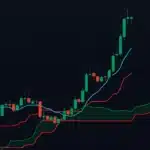Crypto markets saw big “crypto whale” activity in early May 2025. Bitcoin made the headlines when a long-dormant wallet woke up. On May 6, a 12-year-inactive address reportedly moved 1,079 BTC (~$109M) into a new wallet (just hours after BTC went past $100,000) and deposited the entire amount into the Gemini exchange.
In total two 20-year-old wallets moved 3,422 BTC (~$324M) in a few days. Notably, when whales deposit to exchanges it often means selling. Indeed, Bitcoin’s volatility and trading volume spiked around the $100K breakout.
Bitcoin: Dormant Whales Awake
One 2012 wallet reportedly sent 2,343 BTC (~$221M) out of dormancy and another moved 1,079 BTC (~$102M). The latter transaction is the one tracked by Lookonchain who sent all 1,079 BTC to Gemini after the price hit $100K. Lookonchain’s on-chain alert says:
“a Bitcoin whale that had remained inactive for 12 years transferred 1,079 BTC after BTC broke above $100,000, the whale deposited the entire amount into Gemini”.
Market analysts say depositing such a large amount to an exchange can be a sell signal; Binance order books and inflow data was watched closely. CryptoQuant data supports a bullish narrative too: Binance’s BTC reserves fell from 595k to 544.5k BTC between mid-April and early May, which is in line with whales moving coins off-exchange for long-term holds. The combination of dormant-whale reactivation and exchange outflows has tightened supply and caused short-term volatility.

Ethereum: Whale Starts Accumulating
Ethereum whales also moved. According to Lookonchain on-chain data, a big ETH holder started buying on May 6. The whale withdrew 1,700 ETH (~$3.1M) from Binance and added to its wallet to about 5,000 ETH ($9M). Sources report this is after a 6-month break, but the whale is sitting on a ~$3.6M unrealized loss (having bought earlier at higher prices).
Arkham Intelligence confirms the transaction: 1,700 ETH inflow hit the whale’s wallet around 07:30 UTC on May 6. This big buy happened while ETH was trading in a $1,800-$1,850 range.
Traders see this as a long-term bullish signal or dip-buying. If the whale continues to add, it could keep ETH above $2,000. No significant Ethereum outflows were seen; instead this whale’s on-chain activity shows it is confident in ETH despite the recent market lull.
XRP: Massive Whale Transfers ($782M)
May 9, Ripple’s XRP ledger saw whale-scale transfers. Whale Alert reported two back-to-back XRP transactions totaling 370 million XRP (~$782M). The first moved 70M XRP ($148M) from an unknown wallet, immediately followed by a 300M XRP ($633.7M) shift from a Ripple-linked address.
Sources note that these moves “have stirred speculation” as some view them as part of Ripple’s treasury management, others as readiness for large-scale institutional use.
XRP’s price dipped only slightly while trading volume jumped 62% to $3.79 billion during the transfers. On-chain metrics from Santiment show sustained accumulation by large holders: addresses with 1M–10M XRP have grown their share of circulating supply from 8.24% in January to 9.44% by May. This quiet whale accumulation suggests confidence in XRP’s future, amidst regulatory uncertainty.
Meme Coins: PEPE and DOGE Whales
Whale action extended to popular meme tokens. Lookonchain spotted a PEPE whale buy on May 8: the investor bought 500 billion PEPE (~$4.36M), bringing its holding to 2 trillion PEPE ($17.42M). This renewed demand helped send PEPE trading volume surging 168% to ~$1.5 billion, expanding the meme token’s market cap by about $600M in hours. Such aggressive accumulation drove PEPE’s price up ~10% on the day.
Dogecoin (DOGE) whales are also accumulating. Santiment data show DOGE addresses holding 100M–1B coins increased their holdings from 23.4B in March to 25.52B by early May, an increase of ~2.12B DOGE.
This means large DOGE holders are bullish. DOGE has been range-bound around $0.17 to $0.2. Overall, whale buying in meme coins is coinciding with recent price upticks, as investors are getting excited about meme sectors alongside Bitcoin’s rally.

Market Impact & Expert Insights
Experts point out that tracked whale movements often coincide with major market events. CryptoQuant’s QuickTake noted 51,000 BTC withdrawn from Binance in late April/early May, which matches the on-chain trend of supply tightening.
Exchange outflows typically mean institutional buying, which is in line with the Bitcoin rally. Arkham Intelligence and Whale Alert also provided visibility: for example, Whale Alert’s log of the XRP 370M transfer and Arkham’s tagging of whale addresses showed the scale of these moves.
Market strategists say big deposits to exchanges by dormant crypto whales often precede sell pressure, while withdrawals indicate HODLing. So far, major levels have held: BTC is above $100K, ETH is above $2K, and XRP is above $2.20 despite the flows. Trading volumes have surged around these events (e.g. XRP +62%, PEPE +168%). As one analyst put it, “Ripple whales are taking a long-term view rather than reacting to short-term macro signals”.
In short, May 4-9’s crypto whale transactions had immediate and future market implications. Verified on-chain data shows big holders are repositioning: some selling into the highs, others buying the dips.
These moves have already correlated with price moves (BTC’s $100K break and meme coin rallies) and volume surges. While actual selling has been orderly, the sheer amount of value transferred means volatility might follow. Market participants will be watching exchange reserves and price action closely.
FAQs
What is a crypto whale and why does their activity matter?
A crypto whale is a very large cryptocurrency holder (individual or entity). Whales can move markets by buying or selling large amounts. Tracking whale moves helps predict supply changes or price swings.
How are whale transactions tracked?
Large on-chain transactions are public via blockchain explorers and monitored by analytics firms. Tools like Lookonchain, Whale Alert, Arkham Intelligence, and CryptoQuant flag big transfers, so we can report on them in real-time.
What is an exchange inflow/outflow?
An inflow is when coins move from wallets into an exchange; an outflow is when coins leave an exchange to wallets. Inflows often mean whales are selling (adding supply), outflows mean HODLing (removing supply).
Did these whales sell their coins?
Depositing to an exchange can precede selling, but isn’t guaranteed. In this period, whales deposited BTC (selling intentions), while others were withdrawing or accumulating (long term positions). The market reacted with limited price drops, so full liquidation hasn’t happened yet.
How did whale moves affect prices?
Whale activity correlated with price moves. BTC’s $100K break happened with a big deposit. XRP had a small dip but sustained volume after huge transfers. PEPE’s price jumped 10% on whale buying. Big moves can spark volatility, so be cautious.
Glossary
Whale: A single crypto investor or wallet holding an enormous amount of coins (often millions of dollars’ worth). Whale moves (big transactions) can move markets.
On-chain transaction: A transfer recorded on a blockchain (public ledger). On-chain analytics track these transactions directly from the blockchain data.
Exchange Inflow/Outflow: Inflow = coins moving into an exchange (selling pressure). Outflow = coins moving out of an exchange (HODLing or staking).
Wallet Address: A unique alphanumeric identifier on a blockchain where crypto is stored. Whale activity often refers to transfers between such addresses or between an address and an exchange.
Liquidation: For derivatives traders, a forced sale of an under-collateralized position. (Not discussed above, but related to big moves causing price swings.)



















































































































